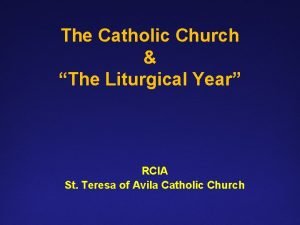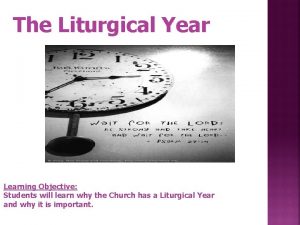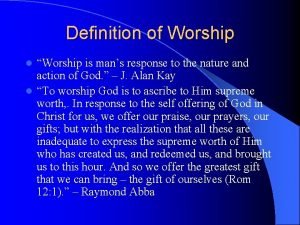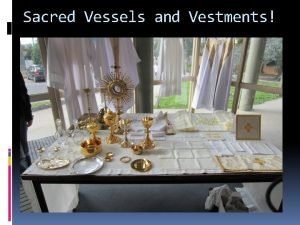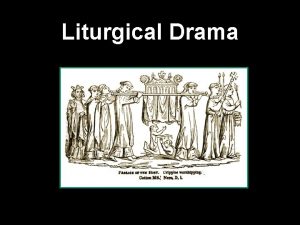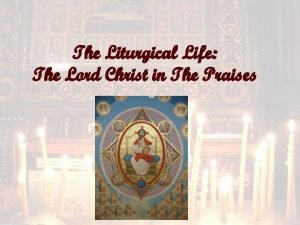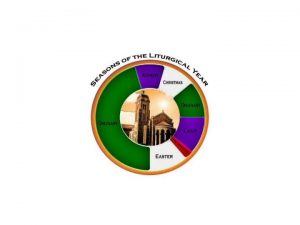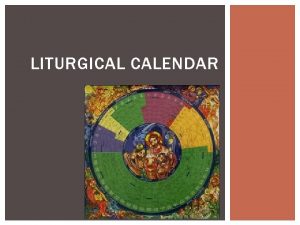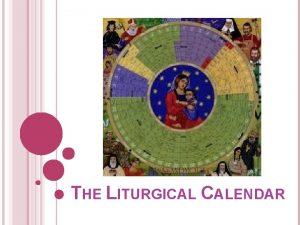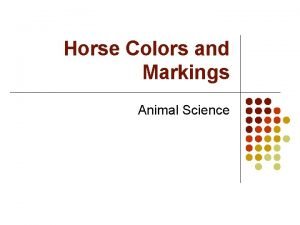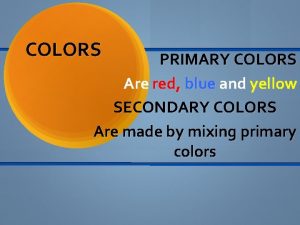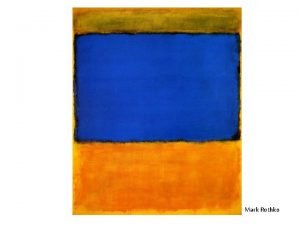THE LITURGICAL YEAR AND COLORS THE LITURGICAL YEAR












- Slides: 12

THE LITURGICAL YEAR AND COLORS

THE LITURGICAL YEAR • Refers to how the Church marks the changing of liturgical times and seasons • We still use the calendar year • But the liturgical year denotes various celebrations and the seasons before or after those celebrations • The major seasons are: • Advent, Christmas, Ordinary Time, Lent and Easter • Each has a particular character (and distinctive color), reflecting our approach and spiritual attitude during that season

THE LITURGICAL YEAR Christmas Advent Ordinary Time Advent Christmas Ordinary Time Lent Easter Ordinary Time

ADVENT • The liturgical year begins with the season of Advent • Approximately 3 -4 weeks long, and begins late November or early December • Changes slightly each year, depending on what day of the week Christmas falls • This year, the first Sunday of Advent is November 29 • Time of preparation and penance before the celebration of the birth of Christ • Also highlights the second coming of Christ, His return at the end of history • Color: Violet

CHRISTMAS SEASON • Celebration of the Birth of Christ • Begins Christmas Day • Traditionally there are “ 12 Days of Christmas” • The 12 th Day is the Feast of the Epiphany of the Lord on January 6 (often moved to the following Sunday) • Over time, the Christmas season has been expanded slightly to include Epiphany and the Baptism of the Lord (mid-January) • Color: White

ORDINARY TIME • 34 weeks • Ordinary, meaning “numbered” • Ordinary time is split into two sections: • The first section is shorter (4 -8 weeks) and begins the day after the Baptism of the Lord and extends until Ash Wednesday • The season picks up again the day after Pentecost Sunday and extends through the rest of the liturgical year • Color: Green, for newness, life, growth

LENT • A penitential season of 40 days in preparation for the celebration of the passion, death and resurrection of Christ, called his “Paschal Mystery. ” • Particularly marked by acts of penance in sorrow for our sins, including fasting, prayer and almsgiving • The celebration of Mass and other liturgies is noticeably subdued • Begins on Ash Wednesday and extends until Holy Thursday evening • Color: Violet, denoting penance

EASTER SEASON • Approximately 50 days long • The great proclamation and celebration of the resurrection of Jesus Christ from the dead • The high point of the entire liturgical year • Begins at the Easter Vigil (the evening before Easter Sunday) and extends until Pentecost Sunday • Color: White, denoting holiness and life

CALCULATION OF THE DATE OF EASTER SUNDAY • Easter Sunday is not a fixed date • It is calculated based on a lunar calendar, similar to the Jewish calendar • Easter is celebrated on the Sunday after the first full moon after the vernal equinox (first day of Spring) • So the date varies each year from late March to late April, depending on the lunar cycle • In 2021, the vernal equinox will be Saturday, March 20. The first full moon after that date is Sunday, March 28. Therefore, Easter will be on the following Sunday, April 4

CALCULATION OF THE DATE OF EASTER SUNDAY • The earliest possible date for Easter is March 22, which will next occur in 2285 • The latest possible date for Easter is April 25, which will next occur in 2038 • From the date of Easter, we count backwards to calculate the date of Ash Wednesday (February 17, 2021) and forwards to calculate the date of Pentecost Sunday (May 23). Thus, the Lenten and Easter seasons are determined.

SUMMARY OF LITURGICAL COLORS • White: • Christmas season, Easter season, feast days of the Lord, the Blessed Virgin Mary and most Saints • Festive occasions such as weddings and baptisms • Funerals, denoting the hope of resurrection • White symbolizes holiness, purity, joy, etc. (in the West) • Violet • Advent and Lent • Other more solemn occasions such as confessions or funerals • Violet denotes penance, preparation, solemnity

SUMMARY OF LITURGICAL COLORS • Green – Ordinary Time (newness, life, growing) • Red • Pentecost Sunday, Passion (Palm) Sunday, Good Friday, feast days of martyrs • Symbol of the fire of the Holy Spirit and of blood • Other colors (optional) • Gold – for solemn high feasts like Christmas or Easter • Black – for funerals or All Souls’ Day • Rose – Worn on 3 rd Sunday of Advent and 4 th Sunday of Lent, reflecting slightly more festive celebrations during otherwise more penitential seasons • Different parts of the world may have different liturgical colors
 000yearold holy mystery
000yearold holy mystery Altered color wheel
Altered color wheel Seasons of liturgical year
Seasons of liturgical year Symbols of priests vestments
Symbols of priests vestments Informal worship disadvantages
Informal worship disadvantages Disadvantages of liturgical worship
Disadvantages of liturgical worship Liturgical vessels and vestments
Liturgical vessels and vestments Liturgical drama examples
Liturgical drama examples Liturgical color for chrism mass
Liturgical color for chrism mass Liturgical objects
Liturgical objects Liturgical background
Liturgical background What liturgical drama uses allegory to relay its stories
What liturgical drama uses allegory to relay its stories Liturgical books
Liturgical books
